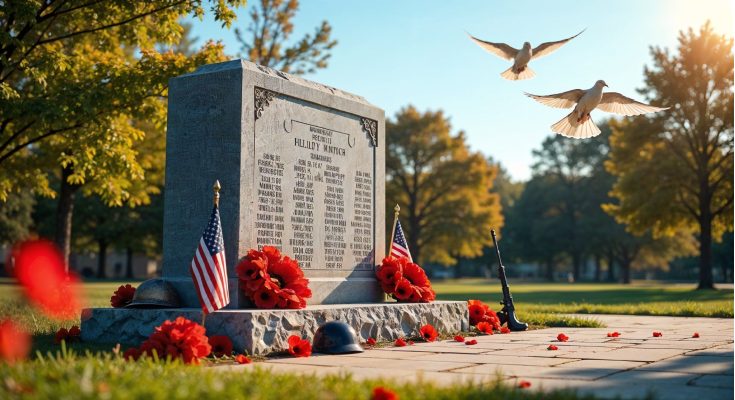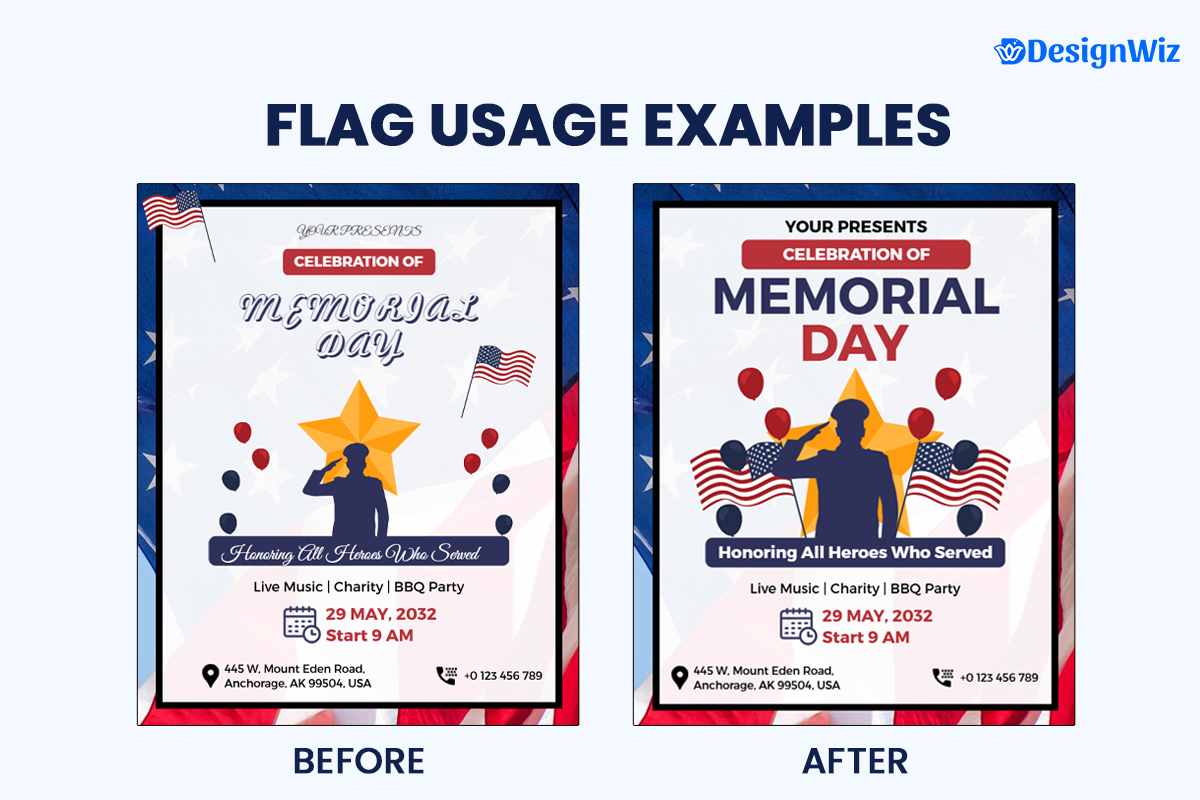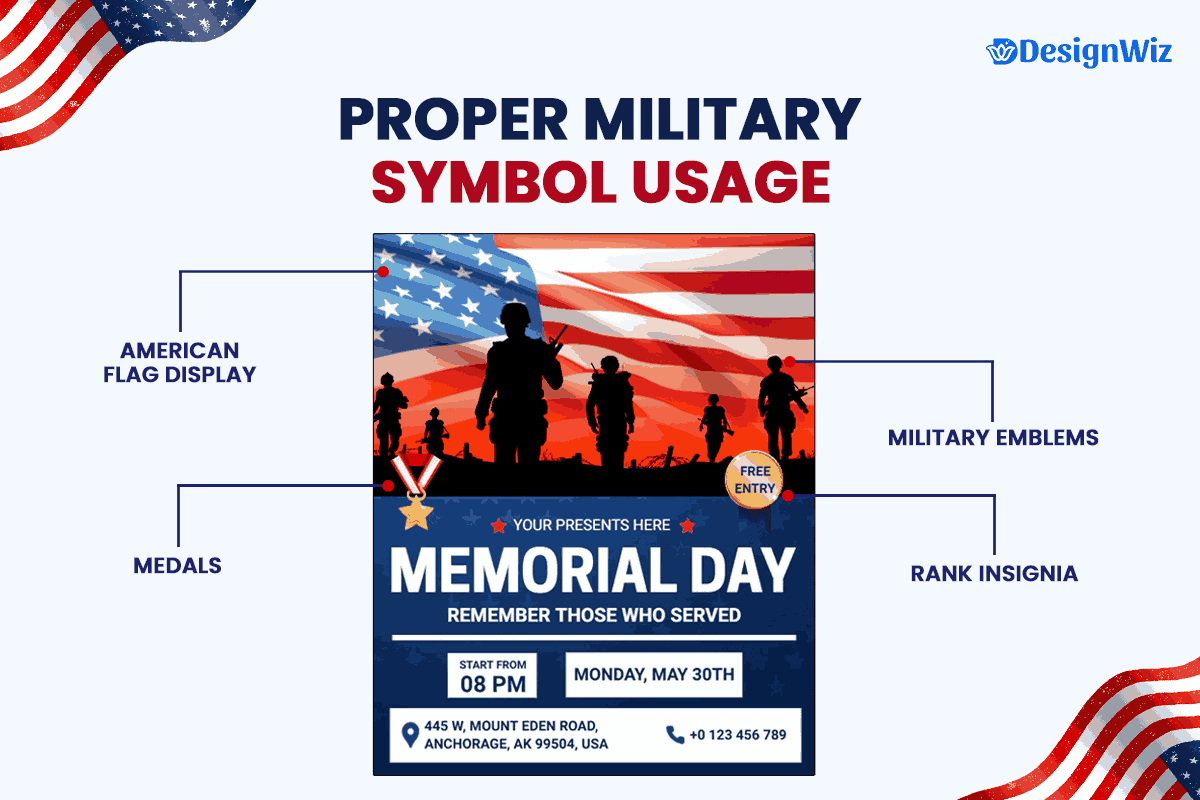Creating effective Memorial Day designs requires understanding the symbolism and imagery associated with this solemn holiday. This comprehensive guide explains the significance of Memorial Day symbols and provides guidance on their appropriate usage in flyers, posters, and other promotional materials.
For a complete overview of Memorial Day flyer design principles beyond symbolism, see our Memorial
Day Flyer Design Guide.
How Should You Use The American Flag In Memorial Day Designs?
The American flag should be used with strict adherence to the U.S. Flag Code when incorporated into Memorial Day designs. Always display the flag with the union (blue field with stars) in the upper left corner when shown horizontally, maintain the official 1:1.9 proportions, and consider representing it at half-staff for morning ceremonies. Never distort the flag, use it as a decorative pattern, or place text directly on top of it in your designs.
Official Flag Display Guidelines
When incorporating the American flag in your Memorial Day designs, follow these official guidelines:
1. Proper Orientation: When displayed horizontally or at an angle, the union (blue field with stars)
should always appear in the upper left corner from the viewer’s perspective.
2. Half-Staff Observance: On Memorial Day, the flag is traditionally flown at half-staff from sunrise until noon, then raised to full-staff until sunset. You can represent this in your designs by showing the flag at half-staff, particularly for morning ceremonies.
3. Proportions: By research of U.S. flag Code research, the official flag proportions are 1:1.9 (height to width). Maintain these proportions when incorporating the flag in your designs.1
4. Colors: Use the official colors which are given below:
| Color | Name | PMS | HEX | RGB |
|---|---|---|---|---|
| Blue (Navy) | PMS 281 C | #0A3161 | RGB(10, 49, 97) | |
| Red | PMS 193 C | #B31942 | RGB(179, 25, 66) | |
| White | – | #FFFFFF | RGB(255, 255, 255) |
Respectful Design Applications
Appropriate Flag Usage
- As a central, standalone element
- As a backdrop when shown in full and proper proportion
- Partially visible but still properly oriented
- Represented through abstract elements (stars, stripes) that evoke the flag
Inappropriate Flag Usage
- Distorted or stretched to fit a design space
- Used as a decorative pattern or background texture
- Placed where it might appear subordinate to other elements
- Shown with text overlaid directly on the flag image
- Used in a way that could be perceived as disrespectful
As noted by California State University symbolism of the American flag, the Pledge of Allegiance, and other national symbols plays a significant role in educational and commemorative materials.2
Flag Design Alternative
If you want to incorporate patriotic elements without using the full flag, consider these alternatives:
What Military Emblems And Insignia Are Appropriate For Memorial Day Materials?
Military emblems and insignia should be used accurately and respectfully in Memorial Day designs, with each branch’s official symbols maintained in their original form. When featuring multiple branches, arrange them in order of establishment (Army, Navy, Marines, Air Force, Coast Guard, Space Force), ensure consistent sizing, and maintain appropriate spacing between emblems. Only use official versions from military websites and avoid random or inaccurate representations of rank insignia and medals.
Branch-Specific Emblems
Each branch of the U.S. military has official emblems that can be incorporated into Memorial Day designs. When using these emblems, maintain their integrity and official appearance.
Army
- The official seal features an eagle with shield, banner, and date of founding (1775)
- Proper colors: Black, gold, white, and red
- Usage: Can be used to honor Army service members specifically
- Sourcing: Only use the official emblem from Army.mil or other official sources
Navy
- The official seal features an eagle with anchor and ships
- Proper colors: Navy blue, gold, and white
- Usage: Appropriate for coastal communities or areas with naval bases
- Sourcing: Only use the official emblem from Navy.mil or other official sources
Air Force
- Official seal features an eagle with a cloud background and stars
- Proper colors: Ultramarine blue, gold, and white
- Usage: Can be used in communities with Air Force bases or history
- Sourcing: Only use the official emblem from AirForce.mil or other official sources
Marines
- Official emblem features eagle, globe, and anchor
- Proper colors: Red, gold, and black
- Usage: Specifically honors Marine Corps service members
- Sourcing: Only use the official emblem from Marines.mil or other official sources
Coast Guard
- Official seal features shield, anchor, and founding date (1790)
- Proper colors: Navy blue, white, and gold
- Usage: Appropriate for coastal communities or port cities
- Sourcing: Only use the official emblem from USCG.mil or other official sources
Space Force
- Newest branch with delta over globe emblem
- Proper colors: Dark blue, silver, and black
- Usage: Represents the newest military branch
- Sourcing: Only use the official emblem from AirForce.mil or other official sources
| Branch | Official Emblem Description | Proper Colors | Usage | Sourcing |
| Army | Eagle with shield, banner, and founding date (1775) | Black, gold, white, red | Honors Army service members | Use only from Army.mil |
| Navy | Eagle with anchor and ships | Navy blue, gold, white | Ideal for coastal communities or areas with naval bases | Use only from Navy.mil |
| Air Force | Eagle with cloud background and stars | Ultramarine blue, gold, white | Suitable for communities with Air Force bases/history | Use only from AirForce.mi |
| Marines | Eagle, globe, and anchor | Red, gold, black | Specifically honors Marine Corps service members | Use only from Marines.mil |
| Coast Guard | Shield, anchor, and founding date (1790) | Navy blue, white, gold | Great for coastal communities or port cities | Use only from USCG.mil |
| Space Force | Delta over globe | Dark blue, silver, black | Represents the newest military branch | Use only from AirForce.mil |
According to, Iowa State University’s Gold Star Hall documentation describes the use of military emblems, patriotic motifs, and memorial symbolism (including the gold star, eagle, poppy, and military insignias) in commemorative design, emphasizing context and respectful presentation.3
Joint Service Representation
For events honoring all military branches, you can incorporate multiple emblems with these guidelines:
- Arrange in order of branch establishment: Army, Navy, Marines, Air Force, Coast Guard, Space Force
- Give equal prominence to all emblems shown
- Maintain consistent sizing across all emblems
- Create sufficient spacing between emblems
- Consider using a unified display format, such as a horizontal or circular arrangement
Rank Insignia & Medals
Military rank insignia and medals require careful, accurate representation.
Appropriate Usage
- When specifically relevant to the event or content
- When accurately depicted and properly identified
- To honor specific units or service types being commemorated
Inappropriate Usage
- Randomly selected without understanding their significance
- Mixed inconsistently or inaccurately
- Depicted in a way that could appear disrespectful
If incorporating specific medals or rank insignia, consult with a military advisor to ensure accuracy and appropriateness.
What Memorial Symbols Are Appropriate For Memorial Day Designs?
Memorial Day designs should incorporate traditional symbols of remembrance that honor fallen service members, such as the red poppy (inspired by “In Flanders Fields”), images of military cemeteries like Arlington, memorial monuments like the Tomb of the Unknown Soldier, folded flags, military dog tags, and memorial wreaths. These symbols should be used thoughtfully and respectfully, providing proper context and avoiding decorative or casual use that might diminish their significant meaning.
The Red Poppy
The red poppy has become an internationally recognized symbol of remembrance for military personnel who have died in wars.
Origin: Inspired by the World War I poem “In Flanders Fields” by John McCrae, which describes poppies growing among soldiers’ graves.
Design Usage
- As a subtle accent element
- As a central symbol in remembrance-focused designs
- Incorporated into borders or backgrounds
- Used as a symbol on commemorative buttons or badges
Color Guidance
| Color | Description | PMS | HEX | RGB |
|---|---|---|---|---|
| Traditional red | PMS 185C | #E4002B | RGB(228, 0, 43) | |
| Green stem (if included) | PMS 348C | #00843D | RGB(0, 132, 61) | |
| Black center | – | #000000 | RGB(0, 0, 0) |
Military Cemeteries & Memorials
Images of military cemeteries, particularly Arlington National Cemetery with its rows of white headstones, are powerful Memorial Day symbols.
Respectful Usage
- As background or context-setting imagery
- In silhouette or respectful photographic form
- With appropriate attribution if using specific memorial images
- With explanatory text providing context
Notable Memorials Often Featured
- Arlington National Cemetery
- Tomb of the Unknown Soldier
- Vietnam Veterans Memorial Wall
- National World War II Memorial
- Local memorials specific to your community
When including images of memorials, provide proper context and recognition of their significance.
Symbolic Elements
These additional elements are commonly associated with Memorial Day and can be tastefully
incorporated:
Folded Flag
- Traditionally presented to family of fallen service members
- Should be depicted in proper triangular fold with blue field showing
- Powerful symbol of sacrifice and remembrance
Military Dog Tags
- Represent the identity of service members
- Can be shown on their own or with other remembrance elements
- Powerful representation of individual service and sacrifice
Boots, Rifle & Helmet (“Battlefield Cross”)
- Symbolic representation of a fallen soldier
- Historically used to mark the location of a fallen service member on the battlefield
- Powerful symbol but should be used thoughtfully and in appropriate contexts
Wreaths
- Represent the cycle of eternal life and memory
- Often used in Memorial Day ceremonies
- Can be depicted with red, white, and blue elements or poppies
How Should You Use Era-specific Military Symbols In Memorial Day Materials?
When using era-specific military symbols in Memorial Day designs, ensure historical accuracy by matching symbols to the appropriate conflict period such as poppies and “doughboy” imagery for World War Blue/Gold Star flags for World War II, specific service medals for Korea, POW/MIA symbols for Vietnam, and contemporary elements for modern conflicts. Choose symbols that are relevant to your audience and purpose, and verify historical accuracy through military or historical resources.
World War I (1914-1918)
- Poppies (most strongly associated with this conflict)
- “Doughboy” imagery (WWI American soldier)
- Biplane silhouettes
- Historical uniform elements
World War II (1939-1945)
- Stars representing service (Blue Star families had members serving; Gold Star families lost someone.)
- V for Victory symbol
- Aircraft silhouettes of the era
- Specific campaign imagery (Pacific theater, European theater)
Korean War (1950-1953)
- Korean Service Medal elements
- Specific maps or locations
- Era-specific uniform and equipment imagery
Vietnam War (1955-1975)
- POW/MIA flag elements (black field with white silhouette)
- Helicopter silhouettes
- Specific ribbon elements
Modern Conflicts (1990s-Present)
- Desert/urban camouflage patterns
- Modern military vehicle silhouettes
- Yellow ribbon elements (support for deployed troops)
When using era-specific elements, ensure they’re historically accurate and relevant to your audience and purpose.
How Should Different Industries Adapt Memorial Day Symbolism?
Different industries should adapt Memorial Day symbolism according to their specific context. Military and veteran organizations can use detailed military symbolism with strict accuracy; community events should balance solemn remembrance with gathering elements; retail businesses should use military symbolism sparingly while clearly acknowledging the holiday’s meaning; and municipalities should adhere to official protocols with formal, dignified representation and may incorporate local history connected to military service.
Military & Veteran Organizations
- Can use more detailed and specific military symbolism
- Should maintain strict accuracy in all military representations
- May incorporate service-specific symbols relevant to their organization
- Should emphasize remembrance aspects over celebration
Learn more about Memorial Day flyers for military and veterans organizations, which focus on honoring service members and promoting solemn remembrance of their sacrifices.
Community Events
- Should balance solemn remembrance with community gathering elements
- Can incorporate local monuments or historical connections
- Should separate commemorative elements from more celebratory community activities
- Can use symbolism that connects historical service to current community values
Explore Memorial Day community event flyer ideas that thoughtfully combine tributes, clearly outline event schedules, and use design elements that honor the holiday while encouraging community participatio
Retail & Commercial
- Should use military symbolism sparingly and respectfully
- Must clearly acknowledge the holiday’s meaning when using patriotic elements
- Should avoid over-commercializing solemn symbols
- Can incorporate subtle patriotic elements rather than specific military symbols
- When designing your marketing materials, consider exploring memorial day retail flyer ideas that honor the holiday’s significance while engaging customers effectively.
Municipalities & Government
- Should use official military symbols with proper protocol
- Can incorporate local history and connections to service
- Should maintain formal, dignified representation
- May use more comprehensive military symbolism if directly related to official ceremonies
For ready to use designs that incorporate appropriate Memorial Day symbolism, explore our Memorial
Day flyer templates
Frequently Asked Questions
No, it’s not appropriate to use the American flag as a decorative background or pattern in Memorial Day designs. The U.S. Flag Code specifically states that the flag should not be used as “wearing apparel, bedding, or drapery” or “for advertising purposes in any manner whatsoever.” Instead display the flag properly as a distinct element or use abstract patriotic elements that evoke the flag without reproducing it completely.
Memorial Day symbols focus specifically on honoring those who died while serving in the military, with an emphasis on remembrance, sacrifice, and honoring the fallen. Common symbols include the red poppy, cemetery imagery, folded flags, and memorial monuments. Veterans Day symbols honor all military veterans, living or deceased, and tend to include more celebratory elements, active service member imagery, and broader military representation.
To ensure accuracy when using military symbols, always source emblems from official websites (Army.mil, Navy.mil, etc.), verify historical accuracy for era-specific elements, consult with a military advisor when using specific insignia or medals, and research proper protocols for display and arrangement. When in doubt, use more general patriotic elements rather than specific military symbols that might be incorrectly represented.
Avoid using overtly celebratory symbols like fireworks, party elements, or beach/vacation imagery that conflict with Memorial Day’s solemn purpose. Also avoid distorted or inaccurate military insignia, randomly selected medals or ribbons without understanding their significance, or imagery that could trivialize military service or sacrifice. Additionally, avoid using religious symbols unless specifically designing for a religious Memorial Day service.
To represent the American flag at half-staff in Memorial Day designs, show the flag positioned approximately halfway down the flagpole or staff, rather than at the top. Remember that on Memorial Day, flags are traditionally flown at half-staff from sunrise until noon, then raised to full staff from noon until sunset. If showing a timeframe before noon, the half-staff position is most appropriate for accurately depicting Memorial Day observance
People Also Ask
1. What does the red poppy symbolize for Memorial Day?
The red poppy symbolizes remembrance for military personnel who died in war. This tradition began after World War I, inspired by the poem “In Flanders Fields” by John McCrae, which described poppies growing among the graves of fallen soldiers. The red poppy has become an internationally recognized symbol of remembrance and sacrifice, particularly associated with Memorial Day in the United States.
2. When should I use military branch-specific symbols versus general patriotic imagery?
Use military branch-specific symbols when honoring service members from particular branches, at events with strong connections to specific branches, or when your audience has direct ties to those branches. Use general patriotic imagery for broader community events, businesses with no specific military affiliation, or when appealing to a general audience. Always ensure accurate representation of any military symbols you choose to incorporate.
3. What’s the proper way to display multiple military branch emblems together?
The proper way to display multiple military branch emblems together is to arrange them in order of branch establishment: Army (1775), Navy (1775), Marines (1775), Air Force (1947), Coast Guard (1790), and Space Force (2019). Maintain consistent sizing across all emblems, provide sufficient spacing between them, and give each equal prominence. For formal presentations, a horizontal arrangement following this order is traditional, though circular or shield arrangements are also appropriate.
4. Are some Memorial Day symbols more appropriate for certain industries than others?
Yes, some Memorial Day symbols are more appropriate for certain industries than others. Military and veteran organizations can appropriately use detailed military symbols and insignia. Community events and municipalities can incorporate local monuments and memorial imagery. Retail businesses should use more subtle patriotic elements and general remembrance symbols. All industries should acknowledge the true meaning of Memorial Day, but the depth and specificity of military symbolism should align with the organization’s connection to military service.
Conclusion
Memorial Day symbolism carries deep meaning and should be used with understanding and respect. By thoughtfully incorporating appropriate symbols, maintaining historical accuracy, and following proper protocols for military imagery, you honor the true purpose of Memorial Day while creating visually effective materials.
Remember These Key Principles
- Use the American flag correctly and respectfully
- Maintain accuracy in all military insignia and symbols
- Choose memorial symbols that appropriately honor fallen service members
- Adapt symbolism to your industry and audience
- Verify historical accuracy when using era-specific imagery
References
- United States Flag Code” Retrieved from 2023, Arizona State University. (n.d.). U.S. Flag Code (Excerpts). Center for Political Thought and Leadership.
- “Patriotic symbols and holidays.” Retrieved April 30, 2025 ,San Bernardino, California State University
- “Gold Star Hall and symbolism of the windows.” Retrieved from Iowa State University. (2024)









